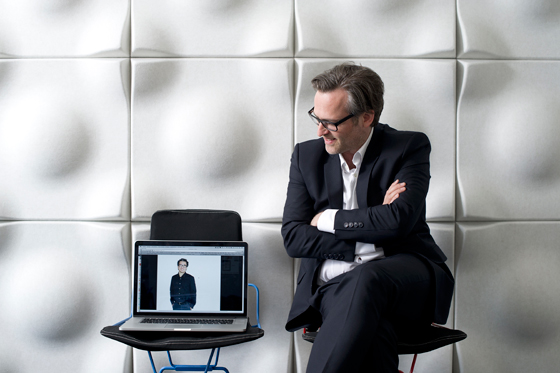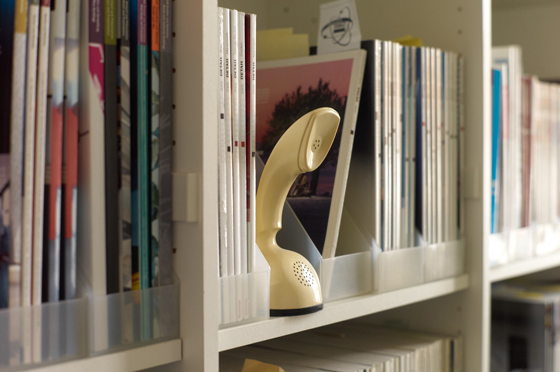“We think totally offline”
Text by Kornel Ringli
Zürich, Switzerland
11.06.13
Tobias Lutz and Nils Becker came unstuck with their first start-up. Their second ranks among the biggest online research platforms for architecture and design. This year sees Architonic celebrate its tenth year in business, while making the leap to America.
Nils Becker online, next to his partner Tobias Lutz (right) in Architonic's Zurich office; photo NZZ/Fabian Stamm

Nils Becker online, next to his partner Tobias Lutz (right) in Architonic's Zurich office; photo NZZ/Fabian Stamm
×These people don’t look like nerds. The 75 staffers at Architonic, one of the largest online databases for design products, conform more, in terms of their outward appearance, to the cliché of architects or designers, rather than to that of your internet freak, as a brief tour of their offices on Zurich’s Müllerstrasse shows. Co-owner Tobias Lutz, who appears at the interview in a dark, fashionable suit, classic white shirt and thick-rimmed spectacles, fits the bill, too.
Student idea
In spite of this, the forthright comment the dynamic 41-year-old makes shortly after striding into the room, comes as a surprise: “For us, the internet is simply paper – just more intelligent. We think totally offline.” How can a successful web entrepreneur talk about the internet in such a cavalier way?
To understand this contradiction, we need to go back to the student days of Architonic’s founders, at the architecture department of ETH Zurich. Here, Lutz met his current business partner Nils Becker, who had catalogued his extensive book collection on a computer database. The electronic card-index made the search for relevant books quick and easy, and frequently served as an information-source lifeline for students prior to their exams. The computer was simply a means of finding, on request, the relevant piece of literature.
Architonic co-founder and passionate book-collector Nils Becker at work
This gave the two students an idea. Like Becker’s book collection, architectural offices weren’t able to get an overview of the plethora of materials, interiors and building products out there, and it was even more difficult for property owners and design lovers. To get a handle on things, you had to leaf through dozens of catalogues or visit a trade fair. Moreover, the industry would send legions of sales people round to architectural practices, but mostly at the wrong time – either too early in the design process or just after decisions about materials had been made. The result: the architects would send the sales rep packing, not having sold a thing. “The purchase need was so infrequent, it was leading to frustration on both sides,” explains Lutz. “Architects needed a tool that allowed them to find the right piece of furniture at the right moment.”
Lutz and Becker launched their first internet start-up at the end of the 1990s. But they were soon at odds with the financial backers over one key issue: the young entrepreneurs were only willing to allow those manufacturers onto their platform who met with their standards in terms of quality and aesthetics. “We held onto our passion for good design,” says Lutz. A split from the investors followed and the duo started out again from square one, founding Architonic with IT brains Dieter Schumann and Thomas Navello.
The dynamic Architonic team keeps things moving at the company's Zurich offices
It wasn’t only this entrepreneurial independence that was different from the first start-up; the decision about where to locate the company was too. They moved from Germany back to Switzerland. “The city’s image is the best fit for our suite of offerings,” explains Lutz, who decides with Becker on a weekly basis which new manufacturers to add to the online catalogue.
The key to success lies as much in the attractive presentation of the products as in the strict selection criteria. The mix of images supplied by the manufacturers is worked on meticulously before publication, so that an optical harmony is achieved on the Architonic platform. Both of the architects know what their fellow professionals pay attention to. Moreover, to achieve credibility, it’s essential the images are augmented with good text and examples of built projects where the products and materials have been applied – but, once again, it’s about quality, not quantity. “We turn information into knowledge,” announces Lutz confidently.
Part of the inspiring 'offline database' at Architonic's generously sized offices
Milestone
He sees the incorporation of specialist retailers as the online reference work’s breakthrough, allowing Architonic access to design-conscious consumers as well as a specialist audience. The former now make up a third of the 44,000 daily users. If you’re interested in acquiring a premium design product, the website will tell you were you can purchase it, but not, however, how deep you’ll have to dig into your pockets. To find this out, a little patience is required – and an enquiry to the manufacturer, made via an online form.
This year sees the company celebrate this tenth anniversary. In spite of its strict admissions criteria, the design platform, available in five languages, contains 140,000 products, 1,200 manufacturers and over 400 retailers. The company, whose income is derived mainly from fees from manufacturers and retailers, has, up until now, been active in Europe, but is venturing into America. Architonic celebrated its entry into the US market just a few days ago. Asia is next.
Architonic's collection of design magazines, which date from the days when phones were less smart but had more curves

Architonic's collection of design magazines, which date from the days when phones were less smart but had more curves
×But there have been flops, too. The biggest, according to Lutz, were the beautifully designed and painstakingly compiled catalogues, in book form, of the best chairs, lamps and sofas, which were already out of date by the time they were printed. Today, the ‘Best…’ lists are, true to the business model, available digitally as an app. That an internet company like Architonic could initially publish them in print form is not as surprising as it may first seem. For the founders of Architonic, the internet is simply a means to an end. Their passion is still for well-designed, tangible objects – like a piece of furniture, a house or a book.
....
This article first appeared in the Neue Zürcher Zeitung on 25 May 2013







